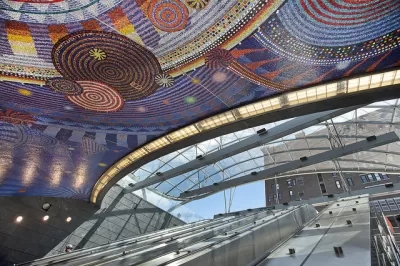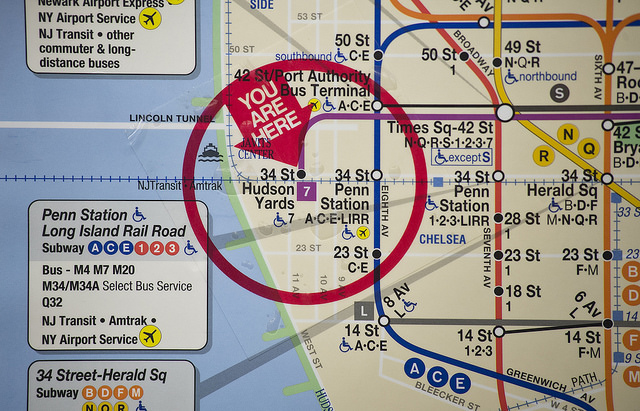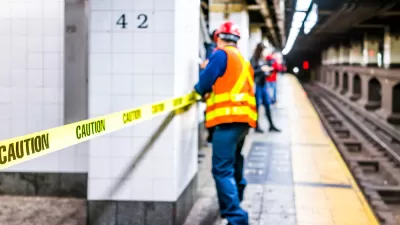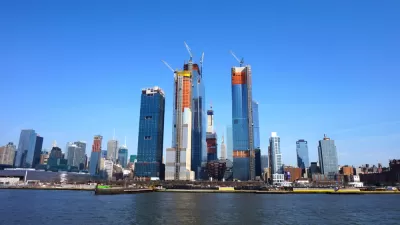On Sept. 13, the Hudson Yards Subway Station, the new Manhattan terminal for the #7 line that terminates in Flushing, Queens, will open with a grand ribbon-cutting ceremony considering the $2.4 billion cost for the one mile extension.

The new No. 7 station at 34th Street and11th Avenue "is expected to initially attract about 32,000 passengers each weekday," writes Emma G. Fitzsimmons for The New York Times. "Because tracks were built as far south as 25th Street, the Metropolitan Transportation Authority (MTA) will have more space to store trains, which officials said would improve service for all No. 7 train riders."
The train currently terminates at the city's busiest subway station at Times Square—42nd Street / Port Authority Bus Terminal on Seventh and Eighth Avenues, and Broadway in Midtown Manhattan," per Wikipedia.

Image credit: Metropolitan Transportation Authority of the State of New York (via Flickr).
San Francisco, where a new plan to build-out its own limited subway using largely local funding was warmly received, should take notice of the new station for another reason: "It is the first subway extension paid for by the city in more than 60 years," notes Fitzsimmons.
Eric Jaffe of CityLab describes the "innovative funding scheme" used to finance the extension financing:
[Former Mayor Michael] Bloomberg wanted the 7 train so badly that rather than wait for the MTA to drum up the money (he’d still be waiting), the administration said the city itself would foot the bill. The funding structure they devised, known as “tax incremental financing,” was an innovative one—at least by the standards of U.S. transportation funding. The city issued bonds for the construction to be repaid by future tax revenue from developers whose property value would soar once the extension was complete.
The scheme works since Hudson Yards is such a massive project, as Planetizen contributing editor Philip Rojc notes in his June 30 post on the development, explaining why TIF financing made sense.
"Development on the West Side is generating so much money in fees and taxes, officials say, that for the first time in a decade, the city will not have to take money out of its budget to make payments on the $3 billion in bonds used to build parks and a subway line in the district."
Gov. Andrew Cuomo may cite the self-financing as reason why the City needs to contribute more to close M.T.A's funding gap, an on-going state-city conflict.
Construction has been underway since 2007 during which time the neighborhood has undergone a "drastic makeover," writes Fitzsimmons.
In what was once a desolate industrial area, cranes dot the skyline as buildings sprout in the Hudson Yards district, which is roughly west of Eighth Avenue between 30th and 42nd Streets. The Jacob K. Javits Convention Center received a nearly half-billion dollar renovation, and tourists flock to the nearby High Line.
Click here to read Jaffe's six other "fun facts about the new 7 Train extension."
FULL STORY: No. 7 Subway Station to Open on Far West Side After Series of Delays

Maui's Vacation Rental Debate Turns Ugly
Verbal attacks, misinformation campaigns and fistfights plague a high-stakes debate to convert thousands of vacation rentals into long-term housing.

Planetizen Federal Action Tracker
A weekly monitor of how Trump’s orders and actions are impacting planners and planning in America.

San Francisco Suspends Traffic Calming Amidst Record Deaths
Citing “a challenging fiscal landscape,” the city will cease the program on the heels of 42 traffic deaths, including 24 pedestrians.

Defunct Pittsburgh Power Plant to Become Residential Tower
A decommissioned steam heat plant will be redeveloped into almost 100 affordable housing units.

Trump Prompts Restructuring of Transportation Research Board in “Unprecedented Overreach”
The TRB has eliminated more than half of its committees including those focused on climate, equity, and cities.

Amtrak Rolls Out New Orleans to Alabama “Mardi Gras” Train
The new service will operate morning and evening departures between Mobile and New Orleans.
Urban Design for Planners 1: Software Tools
This six-course series explores essential urban design concepts using open source software and equips planners with the tools they need to participate fully in the urban design process.
Planning for Universal Design
Learn the tools for implementing Universal Design in planning regulations.
Heyer Gruel & Associates PA
JM Goldson LLC
Custer County Colorado
City of Camden Redevelopment Agency
City of Astoria
Transportation Research & Education Center (TREC) at Portland State University
Jefferson Parish Government
Camden Redevelopment Agency
City of Claremont




























